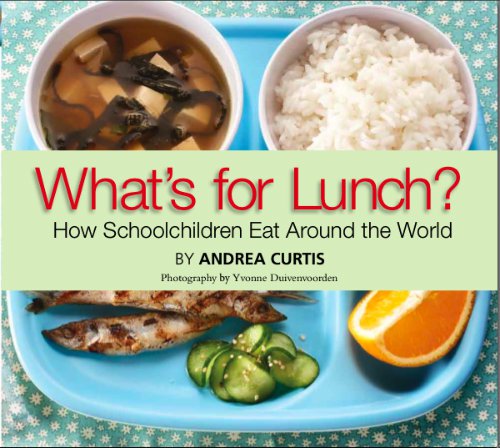
I grew up on school cafeteria lunches. For just 25 cents, we got a hot entrée like so-so creole macaroni, Spanish rice or mac and cheese, brown bread and butter, a forgettable veggie, a yummy, to-this-day-coveted shortbread cookie, and a carton of milk.
That the cookie was the best part of lunch says a lot. But 25 cents is 25 cents, an amazing bargain by today’s standards. At least our bellies were full, and we were not tempted by sugary soft drinks or high caloric snacks from vending machines.
It was not a perfect world by any means; there were no discussions about good nutrition either at home or at school. But there was also no “obesity epidemic,” rampant junk food advertising, or a discernible impact on the environment from the vast amounts of packaging waste produced by our global fast food culture. And it simply never occurred to us that we had the right to a healthy school lunch.
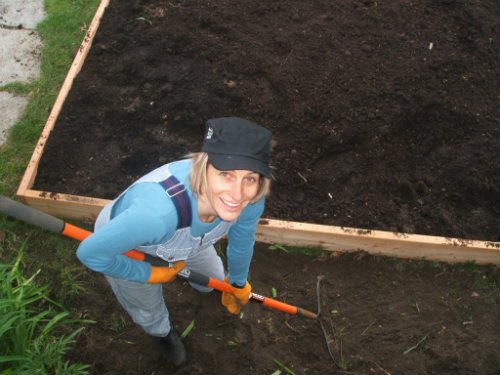
Because it was a constant challenge making school lunches for her two sons every single morning, Toronto-based writer and editor Andrea Curtis became curious about what kids in other countries were eating. In Canada, 90% of kids bring a home-packed lunch and they’re only given about 10 minutes to eat it! There’s no special lunchroom, so they eat in a crowded gymnasium or at their desks. Even when she packed healthy food her sons really liked, often they didn’t have enough time to finish everything.
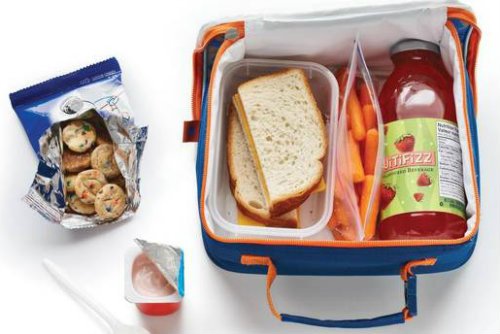
In What’s for Lunch?: How Schoolchildren Eat Around the World (Red Deer Press, 2012), Andrea serves up a fascinating smorgasbord of typical school lunches from 13 different countries. Peering into the lunch trays, bags, bowls and cups of kids from places like Japan, France, Mexico, Brazil, Russia, China and Peru reveals that it’s always about more than just the food itself.
No matter where we live or what we eat, our food is part of a huge, complex global system, with issues connecting and affecting us all, everything from climate change, social justice, inequalities and the plight of farmers to world hunger and diet-related illnesses like diabetes and heart disease.
Kids will enjoy seeing the interesting variety of foods, read about how and where they’re eaten, and noting how they’re similar and different from other kids around the world. They’ll see that for some children school lunch is the only nutritious meal of the day, while others may have adequate food but it’s not especially healthy. It will definitely make them think about food in ways they never have before.
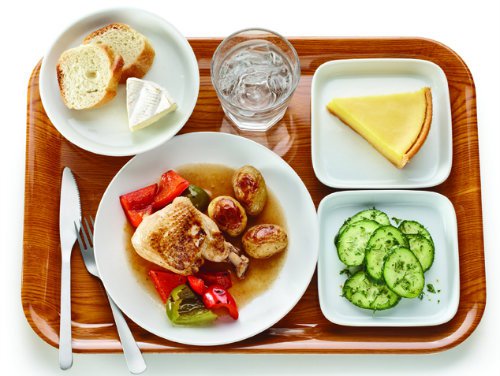
Students in Nantes, France, for example, eat a complete four course meal made from scratch by trained chefs using fresh ingredients. They are given 45 minutes for lunch, use real silverware, and are encouraged to eat slowly and savor their meal, which is served on heated ceramic plates. They also take taste education classes, yet another way to foster lifelong food appreciation.
By stark contrast, students in a Kandahar, Afghanistan, village school, where there is no safe drinking water or proper toilet facilities, eat a packet of high-energy biscuits provided by the World Food Programme. These fortified biscuits serve as breakfast and lunch, and will be the most nutritious food they have all day.
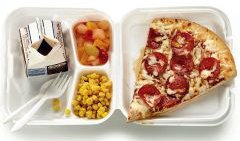
In an interview at Sweet Potato Chronicles, Ceri Marsh asked Andrea which country’s lunch surprised her the most when she was researching the book.
I was probably most surprised by how unhealthy many school lunches are in the USA. I saw things like Frito pie—a casserole of corn chips, chili and piles and piles of greasy cheese—pepperoni pizza and a choice of strawberry or chocolate milk along with canned fruit (complete with maraschino cherries). That’s changing now as Americans have begun to institute their new healthier school lunch guidelines, but it’s been pretty awful for a while.
On the other hand, I was surprised in a good way by Brazil, where there is a huge amount of poverty and yet the government has made it a priority to ensure all children have a healthy and delicious meal at school with fresh fruit, rice and beans and veggies. They also require school meal providers to source 30 % of their food from small-scale local suppliers—helping support local economies as well as children’s health.
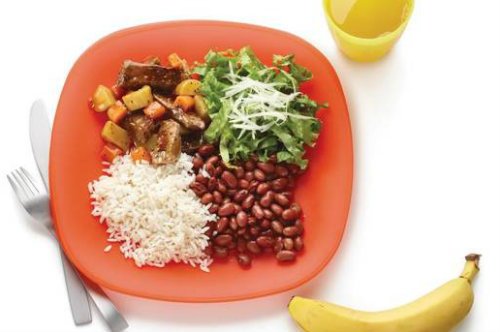
Along with providing an illuminating social, cultural and historical context for the featured lunches, Andrea discusses some of the ways kids are taking an active role in reclaiming school lunches by demanding more nutritious cafeteria options, planting school gardens, and learning to cook healthy meals.
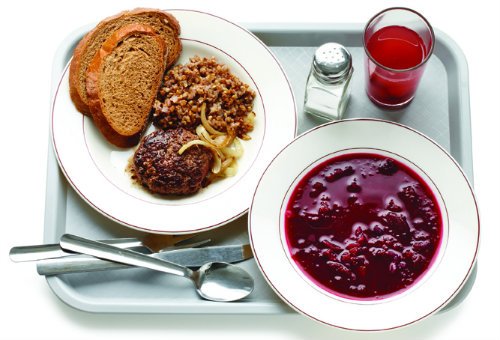
With illustrations by Sophie Casson, color photos by Yvonne Duivenvoorden, and illuminating sidebars about food culture, What’s for Lunch? is a wonderful book for kids and adults to read together because it will inevitably raise important questions and stimulate lively dialogue. In a blog post titled, “Garden Variety Politics,” Andrea says:
I think making food literacy a part of our schools and education system is a key part of how we’re going to reverse the damage of our current food system—the diet-related health issues, the environmental degradation, the fear about food safety and unfair labour practises. Teachers are our most important resource when it comes to making food literacy a part of our children’s school life.
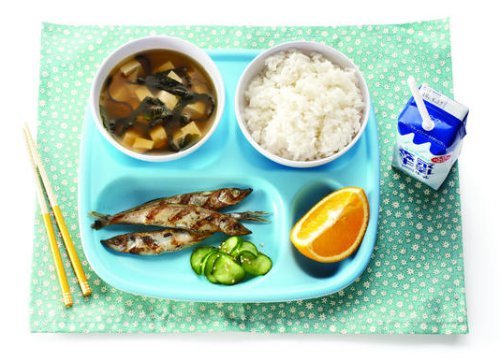
I agree that it’s crucial for kids to learn where their food comes from and how it’s produced, how their diet affects their bodies and the world around them, and that they should have an opportunity to help grow and prepare their own food. What’s for Lunch? shows how a simple school lunch can reflect an entire nation’s values and priorities when it comes to food. I know that it reinforced my belief that in the U.S., making big bucks seems to be more important than maintaining a healthy, safe, and high quality food supply.
More from Andrea in this video:
* * * * *
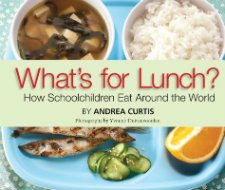 WHAT’S FOR LUNCH?: What Schoolchildren Eat Around the World
WHAT’S FOR LUNCH?: What Schoolchildren Eat Around the World
written by Andrea Curtis
with photographs by Yvonne Duivenvoorden and illustrations by Sophie Casson
published by Red Deer Press, October 2012
Nonfiction for ages 9-12, 40 pp.
Includes Endnote and Glossary
*Paperback original
♥ Visit the What’s for Lunch Website for more about Andrea and the book, including a great list of Learning Resources for teachers, students, and anyone interested in global food issues and Ways to Take Action. Follow Andrea’s Blog, where she continues to share info and insights about school lunch around the world and other cool food initiatives, organizations and news.
* * * * *

“Food literacy,” “food appreciation,” “the power of food.” So important to each and every one of us.
Let’s discuss:
Does your child buy school lunch or does he/she bring a home-packed lunch? Why?
Like Andrea, do you also find it a huge challenge to pack a healthy lunch every day that your child will actually finish?
Does your child’s school still have vending machines stocked with sugary drinks and unhealthy snacks? Does the cafeteria sell chocolate or other flavored milks, french fries and cheese-laden foods like nachos?
* * * * *
——————————————-
*Spreads from What’s for Lunch? posted by permission of the publisher, text copyright © 2012 Andrea Curtis, photographs © 2012 Yvonne Duivenvoorden, illustrations © 2012 Sophie Casson, published by Red Deer Press. All rights reserved.
Copyright © 2012 Jama Rattigan of Jama’s Alphabet Soup. All rights reserved.

What a fascinating book and post. My mom made our lunches every single day – sandwich (tuna, baloney, PBJ, ham), a piece of fruit, and a treat (4 small cookies, Little Debbie snack, etc.). Plus she gave us change to buy a pint of milk. We had a half hour lunch period, plus a school-wide, 10-minute nutrition break earlier in the day. I do know the hot lunches were abysmal then and abysmal now – like the one in the book, mostly canned and frozen garbage. Tater tots and frozen pizza on Fridays.
Here in Italy the kids go to school six days a week from 8-1, so just about everyone eats lunch at home, lunch being the main meal of the day.
And may I just say how fabulous France and Japan are in the school lunch area? If I lived in France I’d be big as a house.
LikeLike
That’s interesting — I like that schedule with having lunch at home. At least kids wouldn’t be rushed through a meal at school. The afternoon siesta is a good thing too. I was always impressed with the different quality of life I noticed from my few brief trips to Italy.
The French have always put such a high priority on food appreciation — and it’s nice to see how that’s implemented in their schools. In addition to these great nutritious lunches, the kids are encouraged to actually make conversation :). And I like how lunch is used as an opportunity to foster social skills, responsibility, cooperation, and good manners in countries like Japan.
LikeLike
Oh gosh, this is fascinating. I gotta order this to read with my girls. That is fascinating about Brazil, in particular. … I have also been amazed, since my girls started school, how little time they get to eat in the cafeteria. I think it’s maybe a total of 20 minutes. It really is wild.
Thanks for this post!
LikeLike
Yes — 10 minutes in Canada, and only 20 minutes in your girls’ school. No wonder Americans are so into fast food. They’re rushed through meals from when they’re little. Not right. Lunch period should be at least 30 minutes! Do you think lunch is kept short because it would require more teacher monitoring once the kids have actually finished their food? Do your kids rush out to the playground after eating? I remember doing that in grade school.
LikeLike
I do pack my kids’ lunches everyday, because the lunch line is so long that the kids only have a few minutes to eat. I’m also not a fan of plastic sporks and styrofoam plates. The waste of food and packaging really bothers me!
Only our high school has vending machines, and I believe they are now stocked with water and healthy snacks.
LikeLike
If the lunch line is long that must mean lots of kids are buying school lunch. What is the general concensus about the bought lunches? Do the kids like it? Do they have any options?
LikeLike
I think parents are working, busy and it takes time to plan and pack lunches. Also, kids want to do what their friends do (aka stand in long lines). I hear that pizza is popular but most of the ‘healthy’ foods are tossed in the trash.
LikeLike
Because I work in an independent school, we are lucky to have good lunches, including a salad bar, but getting students to choose the good ‘stuff’ is a second challenge. This is fascinating, Jama, to hear about lunches all over the world, especially France and Brazil, sadly about Afghanistan and other poorer countries. It’s good that the book is drawing people’s attention to the US & the challenge in obesity. In addition to healthy eating, we also played outside more. Thanks!
LikeLike
Nice to hear about a school with good lunches — but as you say, getting kids to actually eat “what’s good for them” is another challenge entirely.
One of the things that surprised me was to hear about obesity problems in other countries besides the U.S., like China. The impact of Western fast food culture is felt all over the world, with people abandoning their traditional diets in favor of mass produced food. And it was definitely sad to hear about poorer countries — at a refuge camp in Kenya, kids eat a plastic mug of porridge.
LikeLike
Fascinating. I love the idea of teaching food literacy. What could be more important? What we eat — and how it’s produced — has so many impacts on health, animal welfare, the economy, the environment, etc. Kudos to Andrea for raising the issues in such a kid-friendly way. And thank you, Jama, for another excellent post.
As for your questions . . . Jackson has taken a lunch to school every day since elementary school because (a) the few school meals he tried were vile and (b) he doesn’t eat meat, which rules out a lot of cafeteria options. Now that he’s in high school, it seems a lot of kids get their meals from vending machines. He’s still bringing lunch, though I admit mine have never been very creative — usually a bagel with cream cheese or a peanut butter and honey sandwich, with a Chobani yogurt (no gelatin — a meat product found in many flavored yogurts) and chips (gotta have some indulgences!).
LikeLike
Andrea’s book is vital on so many levels. I agree with her that if kids are given the chance to learn more about what they’re eating, where it comes from, etc., and have a stake in growing and/or preparing it, they’ll not only benefit health-wise but become more responsible and informed world citizens. We have to take care of our planet, and what we eat makes a difference!
I hope those vending machines in Jackson’s school offer healthy options!
We have new buzzwords now — food literacy, food politics, food activism — that didn’t exist when I was growing up (dark ages). Thanks for weighing in, Linda :).
LikeLike
Sounds like a great book! I was fascinated by how food affects enrollment. Also, I think it is good when schools use lunchtime as an opportunity to teach “taste,” teamwork, and manners.
I have been making my kids’ lunches for years now. They don’t all eat the same things, so it can be a challenge. I usually give my kids four or five things (for instance, a baked potato with toppings, apple slices, carrots, chips, and a dessert. Or chicken and rice, peaches, cucumbers, and dessert.) My kids eat a lot, so most everything is usually gone.
My 9th grader eats out once a week — his high school lets the kids go off campus for lunch, and they are near a bunch of restaurants. He likes to get Chinese food.
LikeLike
You’re such a pro with home-packed lunches. I remember your mentioning special containers you like to use? Interesting that your son can eat off campus every week. Am wondering what his peers choose for the most part.
Offering free lunches in poor countries definitely affects enrollment — a win-win situation — it’s then a domino effect with profound implications.
LikeLike
What an amazing book! Thanks so much for featuring it, Jama. Sweetpea’s school doesn’t do lunches, so everyone brings their own. The school encourages us to pack good, fresh food, and her lunches are healthy. But I have to say I like the look of those French, Russian, Brazilian and Japanese meals! And I’m truly impressed by the way Brazil has reduced malnutrition and child poverty.
LikeLike
Hooray for Sweetpea’s healthy lunches! I like that she won’t acquire a negative attitude about “school lunches” at an early age like so many American kids do. Good habits from the start!
I’m with you on liking the looks of those other lunches. Of course we’re all wondering — why can’t/isn’t the U.S. like that? We’re a nation of immigrants, with a rich cultural mixed plate, and the best we can do for our kids is frozen pizza and tater tots?
LikeLike
Andrea Curtis has really touched on a critical and timely issue. I love that in Japan and Brazil lunch is not rushed, treated as a social time for learning and sharing. I like that real plates and silverware are used. This has been a concern of mine for years. The idea of more time is critical. I can remember rushing through lunch growing up and not liking it at all. As an educator for 34 years I always felt the same way. The noise, lack of manners and entire atmosphere in the cafeteria is a stunning contrast to the way I was raised; getting worse every year. I will be getting a copy of this title quickly. Thanks, Jama and Andrea. I thoroughly enjoyed the video also.
LikeLike
It’s all about rushing in this country, isn’t it? Bad for digestion, bad for learning, a surefire way to denigrate social behavior. I’m trying to picture kids in an American cafeteria laying out their placemats and then waiting patiently for everyone to be seated before they all begin eating together. Nope.
Thanks for tweeting, Margie :)!
LikeLike
PS I will post about this on Twitter. 🙂
LikeLike
I thought the 20 minutes I got for lunch in high school was criminal; 10 minutes is a downright disgrace.
I packed my own lunch, and it was always a sandwich and a piece of fruit. In high school, where I had the 20-minute lunch, I stopped buying milk to go with my lunch because it took 15 minutes to get through the lunch line, leaving me no time to eat. I would have milk with a snack when I got home.
One thing that seems to be different now, food-wise, from when I was growing up, is that kids often eat differently from their parents. The grown-ups will have “real food” while the kids have chicken fingers or hot dogs or fast food, and so kids aren’t even learning what a healthy meal looks like. I read an article recently that schools that provide healthy lunches find all the fruit and vegetables winding up in the garbage, uneaten. When I was a kid, I was expected to eat what my parents ate. Nobody served me any special “kid meal;” I ate regular food. I’m not sure why this dynamic has changed. Are people just cooking less in general?
LikeLike
Interesting — I think I might have read the same article (NYT?). All the fruits and veggies are thrown in the trash — kids have been conditioned to eat junk food and complain about/reject what’s supposedly “good for them.” But these were high school kids I read about, so you also have to factor in “rebellion” and peer pressure/doing what’s cool into the equation.
I had the same experience as you — I ate regular food, whatever my parents ate, whatever was put on the table. These days you do hear a lot about chicken nuggets, especially, or similar kiddie meals. I think working parents are busy, strapped for time; many families don’t sit down and eat together anymore. Ironically, food shows are more popular than ever and cookbook sales are up, but people in general are cooking less for themselves, cooking from scratch, that is. Microwaving something frozen doesn’t count as cooking.
Don’t like hearing that you couldn’t drink milk with your lunch due to lack to time. So wrong.
LikeLike
Fascinating. I remember the frequently recurring all-starch lunch in the cafeteria circa 1975: pizza, potato chips, corn and a cookie. No kidding.
LikeLike
Sigh. Another reason to move to France!
LikeLike
Thanks so much for this recommendation. I will be picking up a copy for the Docuette Library (student-teacher curriculum library). This topic pops up fairly frequently in the news as I know the Calgary Board of Education has been working on reducing the ‘bad’ food/drinks in vending machines in schools. I like how this book compares North American schools with those found in other countries.
Tammy
Apples with Many Seeds
LikeLike
I think you’ll like the book, Tammy. Accessible format, good info bites, great pictures, inspirational stories of kids/schools taking action. 🙂
LikeLike
wow, I would love to have that French lunch myself..or the Russian.
But can you imagine serving American kids those mackerel? oh no, that would not work I think.
LikeLike
I agree — the mackerel wouldn’t work here, but surely there are some other healthy alternatives that could be served that kids actually like. Most people who see this book are drooling over that French lunch :)!
LikeLike
Very interesting post – thanks for sharing such an interesting subject throughout the world!
LikeLike
Glad you enjoyed the post, Patty. I hope the “movement” for healthier school lunches continues to gain momentum in the U.S.
LikeLike
What a wonderful book! I will definitely get this to read with my son. We’re very good with fresh food where we are, but it’s still interesting to see what other kids are eating. Great idea for a book!
LikeLike
Hope you and your son enjoy it! It’s definitely an eye-opener to compare what kids outside the U.S. eat for lunch. We need to keep expanding this dialogue and move toward healthier options for all students.
LikeLike
Thanks for this post 🙂 I was already aware of it and in the Netherlands kids in primary schools have to bring lunch. Mostly sandwiches. But here things are changing too and schools are starting with guidelines for brought lunches.
LikeLike
Nice to hear some guidelines are being established. Interesting that primary school kids where you live have to bring their own lunches. Thanks for reading!
LikeLike
Very interesting post! Great book. I’ve shared this on facebook, twitter!
LikeLike
Glad you enjoyed the post, Peggy. Thanks so much for sharing!
LikeLike
Really interesting post, thank you. Have a great week!
LikeLike
Thanks, Carole. Hope you have a good week, too :).
LikeLike
Really enjoyed your post, sounds like an interesting book, it’s an eye opener seeing how it’s done in other countries, other cultures. Australians take packed lunches from home but a tuckshop/canteen is available for those that can afford it. Not in smaller schools though. Schools here don’t provide lunches as such but many schools have healthy options in the canteen.
I watched a tv series where Jamie Oliver did a tour of US schools trying to bring about change, I don’t know if it was an accurate portrayal but I was horrified.
French lunch looks the most appealing to me 🙂
LikeLike
Thanks — didn’t know that about Australian schools!
Hopefully things are changing for the better here in the U.S. Old habits die hard. It’s really unfathomable how things could get so bad in “the richest country in the world.” Priorities, priorities.
LikeLike
Since I live in France, I can verify that my kids eat a four-course meal everyday at school, and it is very well-balanced. It’s a world away from the cafeteria lunches I can remember eating as a child in the U.S. I believe it’s made my children better eaters, too, as they are exposed to a wide variety of different foods.and are required to taste everything. No picky eaters allowed!
It also makes dinner much easier on me, since their big meal is at lunchtime. We usually just do a soup and quiche or something lighter for dinner.
LikeLike
Thanks for verifying the French school lunches! It’s wonderful to expose kids to a large variety of foods — you often hear of kids who’ll only eat mac and cheese or pizza or grilled cheese or something, being very picky. Establishing good eating habits at a young age is the way to go. It’s also a good idea to eat a lighter evening meal. 🙂
LikeLike
Such a terrific post and what an informative, interesting book. Thanks for bringing it to my attention.
LikeLike
Thanks for reading, Diane!
LikeLike
This is very interesting! I always took homemade meals with me to school, and I was content with them the majority of the time. In high school I usually brought instant soup along with whatever food I had so just in case I wanted ‘something else’ I had an option and didn’t buy what would taste bad and make me feel terrible later.
I loved looking at the photos of school lunches from around the globe. Thanks for sharing!
LikeLike
Good idea to bring a soup backup! Glad you enjoyed this peek at school lunches from around the world :).
LikeLike
Here in Ontario Canada, many of the school boards have been moving toward two nutrition breaks a day where the students have 20 minutes to eat and not do other activities. They are also removing unhealthy options from the vending machines. it seems to me that this book provides a snap shot of what is happening. My children’s school never had a lunch program, yet some of the city schools had them and the students had the option of hot lunches. very interesting.
LikeLike
Good to hear that things are moving in the right direction!
LikeLike
Wow. You’ve really opened a can of worms here! I think school lunches are disgusting as a teacher. My ten-year-old daughter takes a lunch packed from home almost every day. Kids do not have very much time to eat but at least at her school they’ve changed recess to before lunch instead of after. We have a long way to go and I appreciate Mrs. Obama’s efforts to gear lunches to healthy choices but we have a really long way to go. This book looks fascinating.
LikeLike
One would “think” the U.S. would be on top of something so basic like this. Yes, a long way to go.
LikeLike